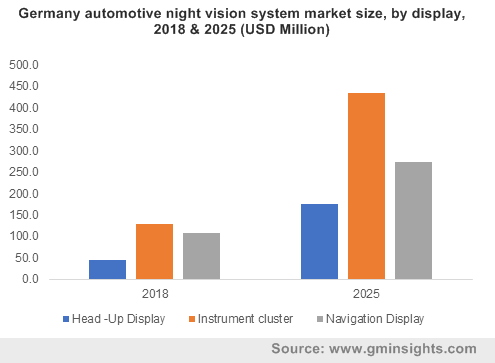Automotive night vision systems market to register double-digit CAGR over 2019-2025
Publisher : Fractovia | Published Date : July 2019Request Sample
Automotive night vision systems market is poised to garner substantial returns over the forthcoming years owing to the introduction of groundbreaking technologies in new vehicle models and electric cars. Growing number of fatal and disabling road accidents resulting from compromised night vision and drowsy driving has compelled the automakers to incorporate active safety technologies that support vehicle maneuvers. Night vision systems in automobiles would extend the perception of the driver beyond the limited reach of headlights through the use of heads up displays, infrared lights and thermographic cameras.
In many emerging economies like India and China as well as across many developed countries, the number of automobile users is dramatically expanding. Underdeveloped driving skills and drivers' low level of awareness of surroundings leads to accidents and increased traffic congestion. According to the European Commission for the Automobile Industry, around 42% of fatal car accidents in the region happen at night, indicating the potential demand for automotive night vision systems industry.
Germany automotive night vision system market size, by display, 2018 & 2025 (USD Million)

Automobile manufacturers are undeniably looking to develop and adopt the latest technologies possible using existing knowledge and skill base worldwide. Automotive night vision systems industry has progressed with the deployment of next generation technologies, such as BMW incorporating optional gadgets ranging from thermal imaging cameras to blind spot detection in its cars. Thermal imaging has become extremely popular using far and near infrared cameras for detecting even the minute changes in temperature. Newest innovations and growing investments in automobile R&D will further expand automotive night vision systems market size.
Autoliv, Inc., a global leader in automotive safety systems, had reportedly announced last year that its electronics business Veoneer had been chosen by one of the leading automakers in the world as a partner to develop and manufacture mono vision camera systems. The company’s night vision camera technology is well-known for its forward collision warning and pedestrian detection capabilities. Similar product developments and partnership undertakings could outline the growth of automotive night vision systems industry.
Prominent automotive players and tech companies are coming up with autonomous vehicles equipped with advanced features like vision sensors, night vision camera, and far infrared camera which play a vital role in vehicle safety. Vision sensors capture and process live images with panoramic views and depth cues that help driverless systems to detect other cars and pedestrians to alert them to quickly stop or slow down. Self-driving sector would certainly pan out to be a viable investment avenue for automotive night vision systems market.
Recently, ZF Friedrichshafen, a global technology company had grabbed the headlines with the launch of dual lens camera for commercial vehicles. This dual cam is designed to help meet changing global regulatory requirements for vehicles and delivers advanced functions like pedestrian detection, traffic sign recognition, and enable automatic emerging breaking. Persistently being addressed by extensive technological interventions in automobiles, automotive night vision systems industry is expected to record commendable gains over the forecast timespan.
North American and European automakers are rapidly improving the connectivity of automobiles via Internet of Things (IoT), novel chips, diverse mobility solutions and autonomous vehicles. These technological changes are propelling the way automobile companies are investing in their future. At the same time, increasing number collaborations with technology startups, by way of acquisition or partnership, has also had a positive influence on the product demand. Gradual rise in luxury SUV sales in the regions has also supported the industry growth. For example, in 2018 Mercedes-Benz recorded 43.3% growth in sales of its GLC model in the U.S. market.
Toyota Lexus, Mercedes-Benz, BMW, Robert Bosch GmbH, among others are some of the prominent players leading automotive night vision systems industry. The rising inclination towards high-tech safety features in cars and massive adoption of cutting edge, cross-industry technologies in design and manufacturing, from augmented reality to deployment of 5G networks, will boost the industry scope. In fact, reports estimate that global automotive night vision systems market will exceed annual valuation of USD 4.5 billion by 2025.